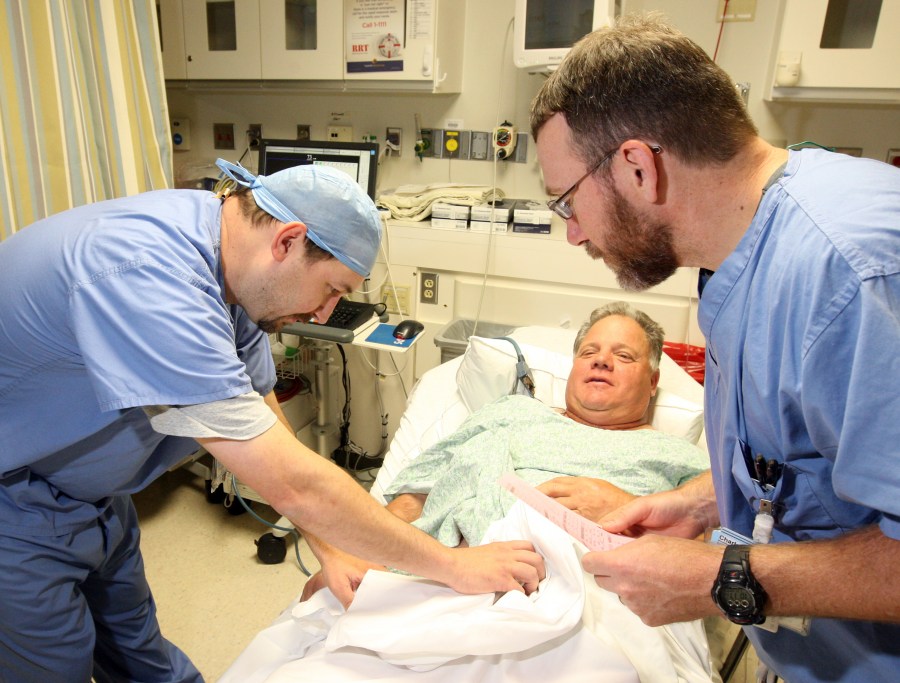
Charles Jolley, R.N., left, catheterization lab procedure nurse, discusses the handover of patient Terry Reeves, a Vanderbilt alumnus, with Matt Anderson, R.N., holding room nurse, in The Vanderbilt Clinic cardiac catheterization lab. (Photo by Steve Green)
Teams seek improved communication for patient handovers
Across the health care system, ensuring effective handover communication is a developing priority, and a sizeable challenge.
Patient handovers occur whenever responsibility for care is transferred from one provider or caregiver to another, as when residents sign out or nurses change shifts or patients pass between hospital teams for testing, procedures or a different level of care.
Poor communication has come to be seen as the cardinal patient safety pitfall, but handovers are neither well studied nor all that systematized.
A spoken exchange between providers/caregivers is indispensable for any handover, according to Sunil Kripalani, M.D., M.Sc., chief of the Section of Hospital Medicine and associate director of the Program on Effective Health Communication at Vanderbilt.
“There is a lot of nuance in patient care and that’s best communicated through synchronous communication,” Kripalani said.
But hospitals are busy places. “Even though the handover is integral, it too often ends up being an afterthought,” said Kelly Cunningham, M.D., assistant professor of Medicine, who has been evaluating a new electronic tool developed at Vanderbilt to support handovers between residents.
“Next to hand hygiene, handovers are the most fundamental process we can perfect to protect patients and improve care,” said Julie Morath, R.N., M.S., chief quality and safety officer. “Our work is to reduce the variation in how providers and caregivers communicate essential information to provide patient care continuity.”
Two years ago, a review of VUMC handovers was conducted. Last year the Medical Center provided handover training for clinicians and nurses. Activity has now shifted to pilots aimed at sharpening the consistency and focus of handover communication.
In 2005, a group led by Matthew Weinger, M.D., settled on the OR-to-PACU handover as a good place to test the effectiveness of medical simulation in improving communication. In the PACU (post-anesthesia care unit), just after surgery, anesthesiologists transfer responsibility to nurses.
Weinger’s group defined an effective handover, produced a video with actors portraying good and bad OR-to-PACU handovers, asked an expert panel to score each portrayal for handover effectiveness, then used this material to train field workers to observe and score real handovers.
Then came the actual intervention: anesthesiologists, nurse anesthetists and PACU nurses together participated in simulated handovers, mounted with actors skilled at posing realistic barriers to communication. Trainees were confronted with uncooperativeness, interruptions and outright conflict. Video of each session was reviewed immediately by participants, who were joined in discussion by trainers.
“I would summarize the training as sensitivity training for anesthesia providers and assertiveness training for the nurses,” said Weinger, who is the Norman Ty Smith Professor of Patient Safety and Medical Simulation. “Really this was interpersonal skills training within the skin of handover training.”
Within several months, handover scores were transformed: the proportion of “acceptable” OR-to-PACU handovers went from 7 percent to 70 percent in the main adult PACU, and from 22 percent to 77 percent in the pediatric PACU.
Resident to resident
Beginning this July, America’s first-year residents won’t be allowed to stay on call more than 16 hours at a stretch. While this tightening of the current 30-hour limit may bring fewer exhaustion-related medical errors, it will also necessitate many more handovers and bring more opportunity for handover-related errors. Not coincidentally, this year “handover competency” is a new accreditation requirement in U.S. graduate medical education.
Two years ago, as a first-year resident, Matt Semler, M.D., began thinking about new IT support for handovers. He soon found himself spearheading such a project, after a handover-related medical error was featured in one of Internal Medicine’s morbidity, mortality and improvement conferences.
With the backing of Neal Patel, M.D., M.P.H., chief medical informatics officer for inpatient areas, Semler and fellow residents began testing an electronic tool for more focused and efficient handover documentation.
Patient by patient, the resident who is signing out types in any anticipatory guidance for the coming hours and any tasks to be completed. The tool automatically pulls in each patient’s allergies list, current medications and the summary section of the progress notes.
The user prints the completed document for use as a reference during the handover conversation. In the morning, before the two residents again talk, the night-covering resident uses the tool to note any overnight events.
Last year the tool was adopted by all Internal Medicine resident services, as well as by non-teaching services at VUMC. It’s now being adopted by other services at VUMC.
“I think the next step needs to be continuing to realize that the tool is just that — it doesn’t replace the conversation,” said Kelly Cunningham.
Nurse to nurse
Cardiology patients at Vanderbilt University Hospital are taken to the Cath Lab for procedures such as angioplasty and stent placement. There’s potentially a lot to cover in these nurse-to-nurse handovers, especially as patients return to their floors following a procedure.
“Taking direct care of patients, nurses are sharp-end caregivers, so handovers are crucial,” said Dana Wilson, R.N., M.B.A., manager of the Cath Lab and EP Lab.
Last fall the Vanderbilt Heart & Vascular Institute asked inpatient nurses for their ideas on what should be covered in these handovers. Based on this input, the Heart Institute promoted a more structured handover, and in follow-up surveys, nurses say these handovers have become more effective.
The effort to improve handovers is sponsored by Associate Hospital Director Nancye Feistritzer, M.S.N., R.N. For more information, contact Shea Polancich, Ph.D., director of patient safety.













